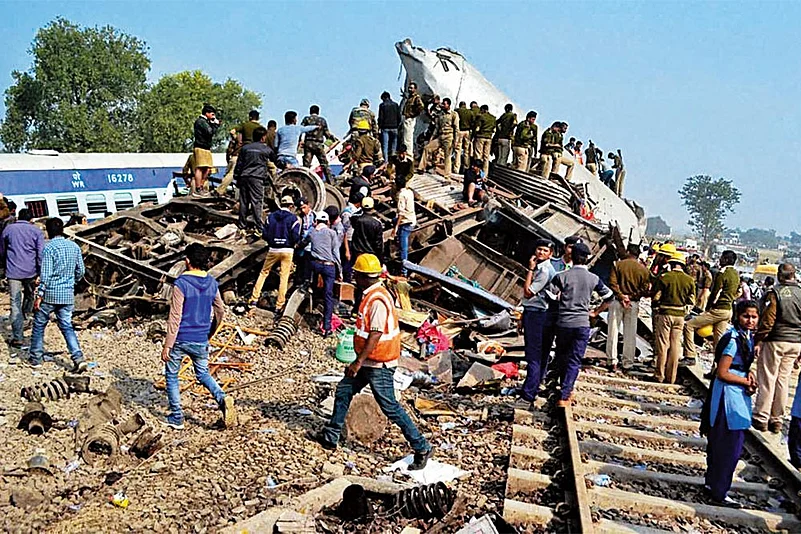If Suresh Prabhu looked relaxed after finance minister Arun Jaitley subsumed the Railway Budget within the general budget on February 1, it perhaps also masked the loss of an opportunity to helm a whole conceptual transition for the railways. Sure, Prabhu had been spared the onerous, but thankless job of trying to present a rosy picture of finances when none existed. He didn’t have to spell out what happened to the High Speed Rail Authority, meant to implement the government’s famous bullet train promise. Or how 48,000 hectares of vacant railway land could be monetised to shore up non-fare revenue. He didn’t have to walk the populist track and announce a slew of new trains and lines. He didn’t even have to touch the tricky area of fare hikes—either risking one on the eve of crucial assembly polls, or letting status quo prevail and causing more harm to the financial health of the behemoth.
Instead, Jaitley made it easier by unveiling a new paradigm to fix passenger fares, essentially enabling a hike. Tariffs would henceforth be set “taking into consideration cost, quality of service, social obligation and competition from other forms of transport”, he said. Sources in Rail Bhavan told Outlook that by introducing these criteria, the finance minister has freed the railway fare structure from populist and political pressures. “A hike in fares, especially in the highly subsidised passenger segments, including sleeper and non-AC classes, will soon be announced. It can be anything between seven to 10 per cent,” a senior railway official disclosed.
Fares in AC I and II were already pretty high and, what’s more, this is the segment that faces competition from airlines. So there was little scope for a hike there, the official explained. “There’s still some margin (for a hike) in AC III. But the main target is likely to be non-AC classes where barely 35 per cent cost is recovered by railways. Even taking social obligation into account, at least 50 per cent cost should be recovered,” he added. Suburban train fares, unchanged for years, could also see a hike.
Incidentally, Prabhu’s pet theme of two years—a Rail Development Authority (RDA)—found no mention. Planned as an independent tariff and freight regulatory authority, its job was envisaged as delinking the fare and freight structure from political exigencies. The power to fix fares was to be transferred from politicians to technocrats, with the underpinning logic being economic rather than populist.
On a broader canvas, it was to be empowered to resolve disputes and ensure a level playing field for private investors. As for fare structures, a cabinet note on the RDA had underlined the nature of its autonomy. If the government did not “accept” suggested tariffs, it would have to “compensate the organisation appropriately”, it said.
Even an enhanced gross budgetary support of Rs 55,000 crore against an annual capital expenditure fixed at Rs 1,31,000 crore—described as “unprecedented” by Prabhu—leaves the railways in need of extra-budgetary resources. “Since Jaitley has only announced the capex plan, it’s the duty of the finance ministry to help us find that money. Any debt by a body like railways is a debt of the government too,” Prabhu said after the budget.
A touch of controversy had already marked the Rs 94,000-crore capex figure for 2015-16, with railway officials themselves raising questions—at least 25 per cent of it was not actually used to create capital, they said, but included money extended to implementing agencies for future works and equity infusion into rail PSUs. “The railways will have to be completely transparent in showing how they utilise the Rs 1.31 lakh-crore capex,” a senior government functionary told Outlook. “They’ve shown they lack a mechanism to spend this kind of money.” The absence of a separate railway budget only sharpens the scepticism, he said. “Maybe the ministry should be asked to give some sort of a monthly report to the finance ministry.”
Safety was the other big theme. The railways have been badly floundering of late, with three derailments in as many months killing 200 passengers. Rail officials say there is too much pressure on the system, with poor, ageing infrastructure and little time for maintenance. The move to set up a ‘Rashtriya Rail Sanraksha Kosh’ (National Rail Safety Fund)—with a corpus of
Rs 1 lakh-crore for five years—was welcomed by most. Says D.P.S. Sandhu, a former railway officer now with audit firm KPMG: “With one billion tonnes of traffic and 23 million passengers daily, safety can’t be undermined. The money needs to be spent carefully.” Prabhu says India is “in talks with countries like Japan to know the best global practices.”
Shifting the accounting method to an accrual system by 2018-19 was also a big reform step, according to Sandhu. The scrapping of the Foreign Investment Promotion Board may present a timely advantage to the railways, he feels, as it could robustly examine a new alternative source for funds. Listing railway PSUs such as IRCTC and IRCON on the stock exchange too will help unlock their underlying value, he feels.
















